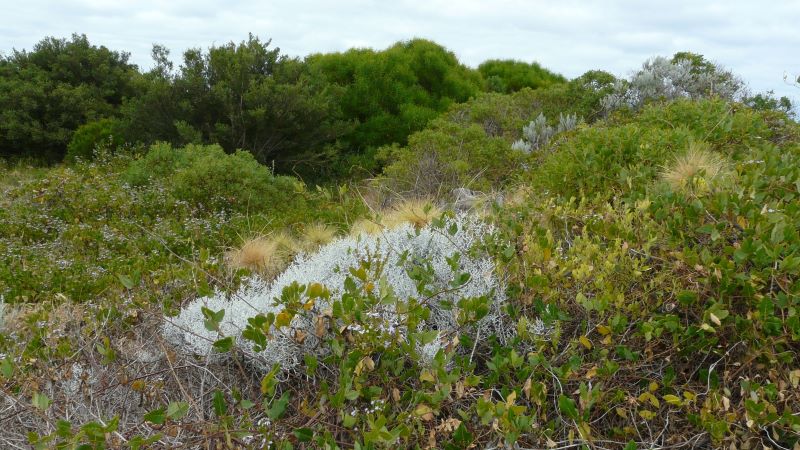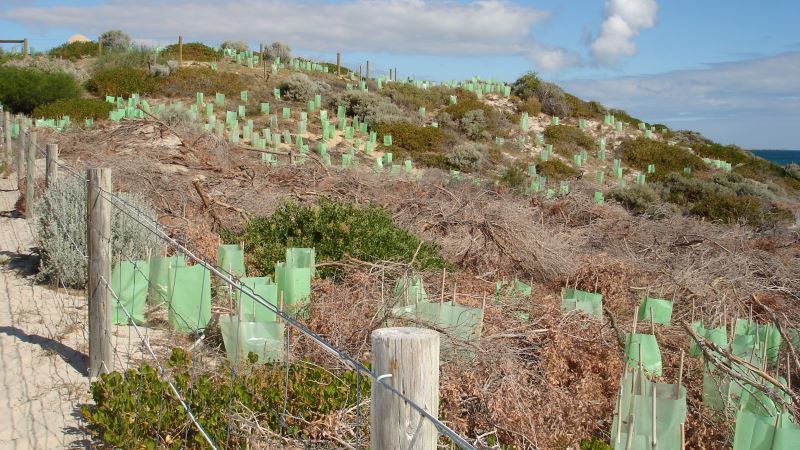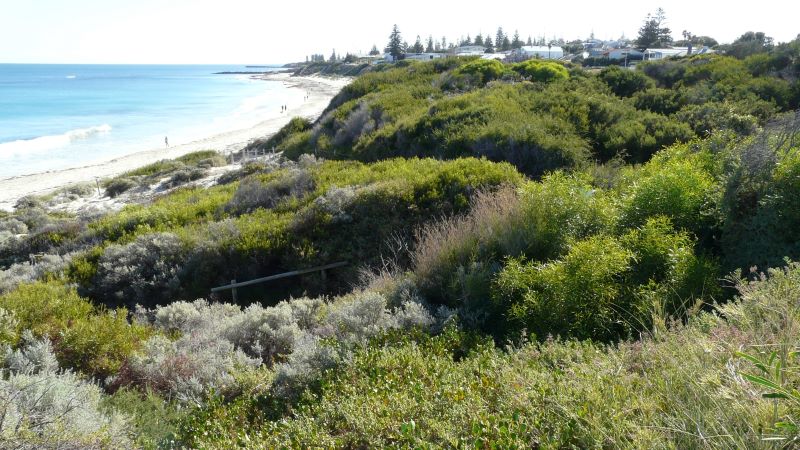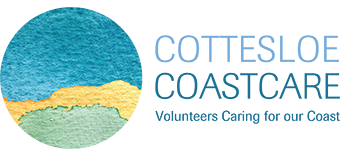Vlamingh
Vlamingh is the most southerly of our sites, just on the border with Mosman Park. It is also the site of our fabulous, new Nature Discovery Space. It is a place for kids to explore, find, touch, climb and make things from sand, sticks or gum nuts. You can see how this weedy degraded site has been transformed into a fun and exciting space for kids to explore here.
This was one of Cottesloe Coastcare’s (CCA’s) original restoration sites. In 2005 a Coastwest grant paid for a ramp and fencing and Coastcare volunteers weeded and planted local species. A 2010 Caring for Country project saw a mass of Victorian tea trees removed and mulched on the sea-side of the path. Coastcare volunteers then planted 3,500 seedlings into the tea tree mulch. The mono-culture of tea trees has now been replaced by a diverse and vigorous array of local species.
2019 has been an exciting time here. After taking out more weedy tea tree we planted local trees such as tuarts, Rottnest pines and Fremantle mallees. In July on National Tree Day we had a terrific session organised by Perth NRM and Town of Cottesloe. Over 1000 plants went in with help from Cottesloe Cubs, West Perth Rotary and Christ Church boys.
We hope that White-browed Scrubwrens and Purple-backed Fairy wrens, bobtails and geckoes such as the interesting diurnal spiny-tailed gecko might in time use this restored area.
Vlamingh memorial
The memorial commemorates the landing by Dutch explorer Willem de Vlamingh’s expedition. On 5 January 1697 over 80 men from the the ship Nijptangh landed somewhere on the coast near Cottesloe and explored inland to the Swan River. Vlamingh named both Rottnest and the Swan River.
The beach here is where the submarine cable connecting Perth to Europe via the Cocos Islands and Africa landed in 1901. The second Cable Station built in 1926 sits opposite. The mounds under the memorial cover the remains of searchlights installed by the army in the Second World War.

2019 Terrific National Tree Day team.

2019 Sketch plan for our new nature discovery area.

2010 Planting after tea tree removed.

2018 Same site 8 years later.

2006 Victorian tea tree removed and planting started.

2018 Good cover now with local vegetation.
What we are protecting
Blue Banded Bees

You may be lucky enough to see some native bees here, including the blue banded bee. This beautiful bee has blue and white stripes on a glossy black abdomen. They have large bulging eyes with multiple lenses, and a long ‘tongue’ that enables them to extract nectar from trumpet shaped flowers. Unlike honey bees they can hover and ‘buzz pollinate’ plants such as Dianella revoluta.
The females build a nest hole in soft sandstone or clay and deposits eggs and food. Males don’t build nests and roost for the night clinging to plant stems, fighting for the top spot! Blue banded bees fly only in warm months of the year (October to April) and die before the winter.
Sword Sedge (Lepidosperma gladiatum)

Sword Sedge or Lepidosperma gladiatum is known as Kerbein by Noongars. The underground stems were used as a food plant, it was a good source of starch and is eaten raw. It’s a common coastal species and grows very well in the Vlamingh vicinity. It is an important species in CCA’s restoration work as the root system binds the sand and plants send out rhizomes creating large clumps of sedge.
Related stories
Old jetty or wooden groyne?
28 October 2022/by Sue FreethA home for our Ospreys!
9 September 2022/by Sue FreethFantastic News!
5 June 2022/by Sue FreethPlanting 2021
30 June 2021/by Sue Freeth2020 wrap up!
3 February 2021/by Sue FreethThank you Minderoo!
2 September 2020/by Sue FreethOur wonderful nature discovery space is now open!
4 August 2020/by Sue FreethOur wonderful nature discovery space
5 May 2020/by Sue FreethCottesloe Coastcare Association
PO Box 32
Cottesloe WA 6911
info@cottesloecoastcare.org
Sign up to our Newsletters
To stay up to date with our news and upcoming events.
